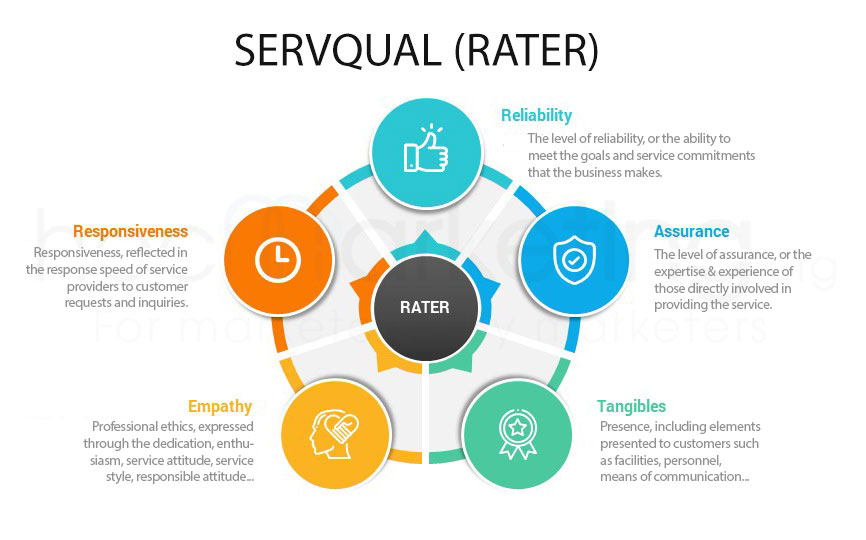
What is SERVQUAL? How to control & increase service quality?

What is service quality? What is the SERVQUAL model? How to apply SERVQUAL model to service quality assessment? How to improve service quality in business?
Services always play an essential role in the business activities of businesses, stores and organizations. For establishments dealing in tangible products such as food, fashion, machinery, equipment..., service plays the role of an indispensable condiment to help improve customer satisfaction. For service businesses (barbershops, spas, tourism, transportation, dentistry...) its role is even more important. So, the question is how can businesses control and improve service quality. We will find the answer together in this article.
What is service quality?
Service is the process of providing value to customers, to help customers satisfy a certain need, through human and (or) machine activities.
For example: Delivery service, warranty & repair service, massage service, spa...
Service quality is a concept that reflects the level of value that service brings to customers, expressed through customer satisfaction. This is also the core factor to build values such as trust, prestige... for a brand.
The important of service quality control
Before you want to improve the quality of service for your business, you must learn how to control it. That is, you have to change how to evaluate the current service quality of the business, know whether the service quality is at a high or low level, so that there are correct directions and plans in the stage of improvement.
To control service quality, we need to understand the elements that make up it. You can qualitatively separate these elements according to the SERVQUAL model.
What is SERVQUAL?
SERVQUAL (also known as RATER) is a model designed to capture consumer expectations and perceptions of a service in five dimensions believed to represent published service quality. for the first time in 1988 by a group of academic researchers, including A. Parasuraman, Valarie Zeithaml and Leonard L. Berry. Since this time, SERVQUAL has gradually been widely used in research and service quality surveys. The elements that make up SERVQUAL (RATER) include:
R = Reliability: The level of reliability, or the ability to meet the goals and service commitments that the business makes.
A= Assurance: The level of assurance, or the expertise & experience of those directly involved in providing the service.
T = Tangibles: Presence, including elements presented to customers such as facilities, personnel, means of communication...
E = Empathy: Professional ethics, expressed through the dedication, enthusiasm, service attitude, service style, responsible attitude... of the participants in the service provision process.
R = Responsiveness: Responsiveness, reflected in the response speed of service providers to customer requests and inquiries.
Enterprises can design a questionnaire based on the SERVQUAL (RATER) model for surveys to control and measure their service quality in the most accurate way.
Using SERVQUAL model to improve service quality
There are 5 aspects that businesses can consider to improve to improve service quality. Depending on the case, businesses can choose to improve one of the following aspects or all of the following:
1. Improve facilities
Facilities affect a customer's first impression, as well as participate in the service delivery process (besides the people). In case the equipment, machinery, tools, rooms... involved in the service provision are too old, it's time to think about repairing or replacing them. Surely, customers will get a better impression after this improvement.
2. Improve staff qualifications
The qualification of the staff, who are directly or indirectly involved in the service delivery process is a core factor determining the quality of that service. Professional qualifications are expressed through working speed, accuracy, efficiency, communication ability, confidence, assertiveness... Imagine, in case your employees faltered first. questions from customers, or often mistakes in service performance... then it's time for you to review and improve in this regard.
3. Improve staff service attitude
No matter how high the professional level (professional level) of your staff, if the service attitude is not good, customers will still rate your service as poor quality as usual. Service attitude is expressed through facial expressions, tone of voice, language, interest... that service staff give to that customer. Customers will hardly be satisfied if served by an employee who is often ignored, swaggering, aggressive... no matter how good this employee's professional level is.
4. Improve service process
Sometimes the problem that affects service quality lies in the service delivery process of that business, specifically falling into the following two cases:
In the first case, the service provider does not follow any specific process, making the quality of the service provided to the customer uneven, leading to many customers and few customers. In this case, businesses need to consider to apply a process so that the quality of service provided to customers is equally good.
In the second case, the service delivery process that the enterprise builds is too complicated and cumbersome than necessary, thereby leading to slowness, stagnation or even errors in the service delivery process. If this is the case, it's time to consider streamlining your process to regain the quality of service you've inadvertently lost.
5. Improve product quality
In case the product that the business provides to the customer is tangible, the quality of the product is also a factor affecting the quality of the service. Let's say your business offers air conditioning, including on-site installation. If the product that the business provides to the customer is of poor quality, the whole process of providing installation services will also be considered poor quality. In this case, businesses should balance between the cost factor and the cost of each order, if necessary, can increase the price so that the business can bring better products to customers.








